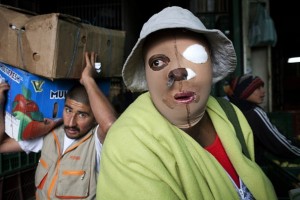Acid attacks on women, and occasionally men, are unfair and horrific acts that commonly occur in Southeast Asian countries like India, Bangladesh,  and Pakistan, among others. Surprisingly reports of this type of violence have started to spring up in the Western Hemisphere in the South American country of Colombia. Any case of an acid attack anywhere is heinous and deserves due attention; but the fact that they’ve never been reported in Latin or South America is attention-grabbing (although this doesn’t mean that they just have been occurring and haven’t been reported). The numbers of attacks in Colombia started emerging in recent years and have rapidly increased in the past months at an alarming rate.
and Pakistan, among others. Surprisingly reports of this type of violence have started to spring up in the Western Hemisphere in the South American country of Colombia. Any case of an acid attack anywhere is heinous and deserves due attention; but the fact that they’ve never been reported in Latin or South America is attention-grabbing (although this doesn’t mean that they just have been occurring and haven’t been reported). The numbers of attacks in Colombia started emerging in recent years and have rapidly increased in the past months at an alarming rate.
When acid attacks are targeted at women they can occur for a wide range of reasons including domestic violence, behavior considered inappropriate, dressing ‘immodestly,’ or refusal of a male’s advances. These attacks can maim, disfigure and even kill a person; leaving permanent scarring and blindness that make daily life difficult to impossible for a victim to function in a normal life (especially if the victim lives in a place with poor medical care and no social support). Psychologically, the effect can be devastating and subject the victim to social stigma.
What’s most disturbing about these attacks is the underlying issue of gender-based violence (GBV) rooted in societies where power is held in the hands of men and runs deep in the cultures of these countries where this type of violence happens. Acid attacks are just one more example of GBV, like rape and physical domestic violence; which serves to keep women oppressed and as secondary citizens in these countries. So, how to deal with an issue like this that has roots in gender inequality and violence in cultures where machismo ideology is rampant? This is something that runs deep in societies (and not as deep in many others, although it’s important that any country with gender inequality still leaves doors open for GBV) and will take long-term and continued efforts at leveling gender inequality and cracking down on these forms of violence.
One way to deal with this is to target GBV at the global level. Large, influential countries should be making GBV an integral part of both their national and international agendas, assisting countries in developing and maintaining programs on GBV so that they are culturally appropriate and sustainable. A good example of this is President Obama’s recent United States Strategy to Prevent and Respond to Gender-based Violence Globally that plans to take a multisectoral approach towards addressing root causes, improving legislation, promoting prevention and improving health outcomes. Although the strategy is new and has yet to be implemented, it has much promise as a model for future national and international GBV strategies.
The rights of women have to be recognized and respected in order to keep women seeking help from law enforcement. So what the law needs to do is just that: enforce. In the countries where these attacks occur frequently, cases of attacks should be encouraged to be reported and thorough investigations carried out. Law enforcement must be more diligent and stricter when it comes to punishing those guilty of acid violence and any other form of GBV. Colombia, although they are suffering from growing numbers of attacks, should be recognized for the significant increase in their prison sentences in the past year. This is a step in the right direction and will take time to start to deter people from committing the crime. But, as long as Colombia follows through on investigating attacks and starts handing down this serious punishment, it will hopefully have an effect on reducing attacks.
Additionally, legislation providing stricter control over the production, distribution and sale of acid would help in keeping acid out of the hands of people (or at least reducing access to it) that have no business using it for nefarious purposes. Specialized medical care has to be available to provide adequate care and minimize damage as much as possible. Bangladesh, in partnership with WHO, has made strides in both of these departments, but like all the other countries where acid violence occurs, there is still much work to be done in raising awareness for preventing attacks. There is no one approach to dealing with acid violence, it must be comprehensive and focused on dealing with the deeper issues of gender inequality and GBV, so that women (and men) never again have to fear acid being thrown in their faces.



